
Blog » Health & Safety » What Fruits and Vegetables Can Dogs Eat?
What Fruits and Vegetables Can Dogs Eat?

The ultimate natural feeding guide for proud dog parents who want to know exactly what fruits and vegetables dogs can eat and how to serve them safely.
Quick Summary: The Best Fruits and Vegetables for Dogs
Wondering what fruits and vegetables dogs can eat? We’ve summarised and grouped some of the best fruit and veg choices for dogs in a way that’s easy to scan and even easier to try. Whether you’re looking to boost their bowl with real nutrients or just want healthier snack options, this is a great place to start.
You’ll find out why each food is beneficial, how to prepare it safely, and which common myths might be stopping you from feeding something simple that could truly improve your dog’s wellbeing — or worse, putting their health at risk without you realising.
Important Note: Not all fruits and vegetables are safe for dogs. Some are toxic, while others need to be prepared properly to avoid digestive upset or longer-term health issues. If you’re unsure, scroll down to read our full lists. Also visit our detailed guide: What Dogs Can’t Eat.
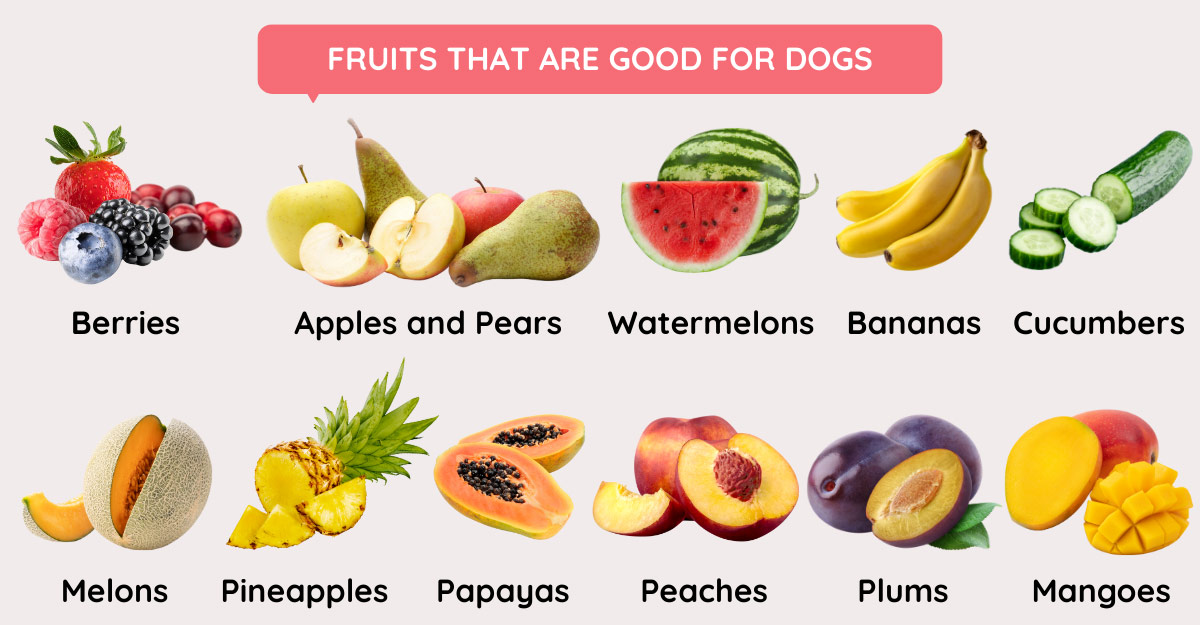
Best Fruits You Can Feed Your Dog
- Blueberries – tiny treats packed with natural goodness
- Raspberries, blackberries, and strawberries – juicy, colourful, and packed with vitamins
- Cranberries – little boosters for overall health
- Apples (seeds removed) – sweet, crunchy, and good for digestion
- Pears – gentle on tummies and naturally soothing
- Watermelons (no rind or seeds) – cooling, hydrating, and ideal for warm days
- Bananas (peeled) – naturally sweet and filling in small amounts
- Melon, pineapple and papaya – tropical treats that aid digestion and gut health
- Cucumbers – crisp, cool, and a great low-cal snack
- Mangoes, peaches and plums (no pits) – soft, sweet, and full of vitamins

Best Vegetables You Can Feed Your Dog
- Carrots – crunchy, naturally sweet, and full of goodness. Frozen carrots also make the best teething chew for puppies.
- Broccoli (in moderation) – a nutrient-rich green that’s great in small amounts
- Green beans – low in calories, high in crunch, and great for snacky pups
- Pumpkin – soothing for tummies and helps with loose stools
- Spinach, kale and leafy greens – packed with vitamins and great for overall health
- Courgettes – easy on the tummy and nice and hydrating
- Celery – crisp, refreshing, and great for fresh breath
- Mushrooms (safe types only, always cooked) – full of goodness and support overall health
- Bell peppers (red preferred) – colourful, crunchy, and full of vitamins
- Asparagus – fibrous and great for gut support
More veg ahead! We’ve covered the full list of dog-friendly vegetables. Jump to the full section for more.
Introduction: Real Food, Real Dogs, Real Talk
Let’s get one thing clear. We’re not vets. But we do care deeply about what goes into our dogs’ bowls.
I actually studied veterinary medicine in the late 1990s. But I realised early on that I was far too emotional to work with sick animals every day. It broke my heart. So I chose a different path. One that still allows me to nurture animals in a way that focuses on prevention, wellbeing, and joyful everyday living.
Even back then, nutrition was barely touched on in vet school. I’ll never forget the lessons on how to bulk up farm feed to keep it cheap. There was almost no discussion of how to feed animals for health. That stuck with me. It shaped how I feed my own dogs and how I view “dog food” today.
Some people still believe dogs are strict carnivores and don’t need fruit or vegetables. But research tells a different story. Even wild canids forage for berries, roots and plant matter when it’s available. And our dogs today? They thrive when we add real, colourful, nutrient-rich foods to their diet.
At The Luna Collection, we believe that food is love. And it’s our responsibility as dog parents to make thoughtful, nourishing choices for the dogs we adore.
If you’re wondering what to avoid, we’ve also written a detailed post on What Dogs Can’t Eat, covering both well-known toxins and common misconceptions.
Now, let’s look at why fruits and vegetables deserve a place in your dog’s bowl.

Can Dogs Eat Fruits and Vegetables?
Yes, they absolutely can. And not only that — they should.
The idea that dogs are strict carnivores is outdated. Dogs are technically omnivores, and even their wild ancestors (like wolves and coyotes) have been observed foraging for berries, roots, and plants when food is scarce or to support digestion.
Adding fruit and vegetables to your dog’s diet introduces a whole range of health benefits, especially when you offer a variety. Different colours, textures and flavours bring different nutrients, and it’s this variety that helps support long-term wellbeing.
Here’s what makes fruits and veg such a valuable addition:
- Fibre – helps regulate digestion, supports the gut lining, and can even help manage weight
- Antioxidants – protect against free radical damage that contributes to ageing, inflammation, and disease
- Prebiotics – natural fibres that feed your dog’s healthy gut bacteria, supporting immunity and digestion
- Polyphenols – powerful plant compounds that reduce inflammation, balance the gut, and may even help prevent cancer
Research from holistic vets and canine nutrition experts has shown how vital polyphenols are in the modern dog’s diet. These plant-based nutrients support healthy ageing, fight oxidative stress, and have even been linked to DNA protection and tumour suppression.
So yes, your dog can eat fruits and vegetables. The bigger question is which ones — and how to serve them safely.
How Much Fruit and Veg Should Dogs Eat?
As a general rule, fruits and vegetables should make up no more than 10% of your dog’s daily diet. This keeps things balanced while still giving them all the goodness that plant-based foods have to offer.
If your dog eats kibble or a cooked diet, fruit and veg can be added as toppers or treats. If you’re feeding raw, they can be mixed in or served on the side, depending on your dog’s preferences (and digestive system).
Portion Tips by Size:
- Small dogs (under 10kg): A few teaspoons a day is plenty
- Medium dogs (10–25kg): A small handful of chopped veg or fruit is a great addition
- Large dogs (25kg+): A half-cup or so of a mix of cooked or raw options, adjusted to suit their needs
Start small, especially if your dog isn’t used to fresh foods. Too much too soon can cause gas or loose stools. Introduce one new item at a time, and always observe for any digestive changes.
Best Practices for Serving:
- Chop or purée veg for easier digestion
- Steam or lightly cook tougher vegetables like broccoli, asparagus, or leafy greens
- Avoid seasoning – no salt, oil, garlic (unless you’re using raw garlic in safe amounts), or onion
- Wash everything well, even organic, to remove dirt and pesticide residues
- Remove seeds, pits, and rinds – we’ll detail this more in the fruit and veg sections coming up
Fresh is best, but frozen works too — especially in summer. And remember: just like with humans, variety matters. Rotate different fruits and veg across the week, and aim for all the colours. Eating the rainbow isn’t just pretty, it’s how your dog gets a full spectrum of nutrients and natural health boosters.

Fruits Dogs Can Eat
Fresh fruit is one of the easiest, healthiest ways to add a splash of colour and nutrition to your dog’s bowl. It’s full of fibre, antioxidants, and natural compounds that support everything from digestion to immune function.
Most dogs enjoy fruit as a refreshing snack, and it’s a great way to boost their bowl with something naturally sweet without reaching for processed treats. The key is choosing fruit that’s safe, preparing it properly, and serving it in moderation. Fruit should always be an addition, not a main part of the diet.
Just like veg, fruit should make up no more than 10% of your dog’s daily intake when combined.
Let’s start with one of our favourite fruit groups: berries.
Berries for Dogs
Little in size, big in benefits. Berries are full of antioxidants, fibre, and plant compounds that may help fight inflammation, support immunity, and even reduce the risk of disease. They’re also lower in sugar than many other fruits, making them a smart choice for dogs watching their waistlines or with diabetes.
Important Note: Always choose fresh or frozen berries with no added sugar or preservatives. Avoid wild berries unless you’re a foraging expert, as some varieties can be toxic to dogs. If you’re not 100% sure what it is, don’t feed it.

1. Blackberries
Blackberries are bursting with antioxidants, including anthocyanins, which give them their dark colour. These compounds have been studied for their anti-cancer and immune-supporting properties. High in fibre and low in sugar, blackberries make smart treats for dogs. Serve them fresh or frozen, and always chop or mash if you’re unsure about your dog’s chewing habits.

2. Blueberries
Blueberries are one of the best fruits you can give your dog. They’re packed with antioxidants, including flavonoids, which help protect cells from damage and support brain health. Studies have even shown that dogs fed blueberries may have higher antioxidant levels, especially after exercise. Serve them fresh or frozen, whole or mashed. They’re small enough for most dogs to eat safely, but if you have a gulper, consider mashing them into food.
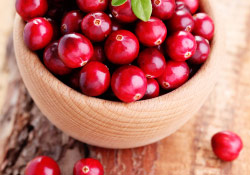
3. Cranberries
Cranberries are most famous for supporting urinary tract health, but they’re also rich in antioxidants and vitamins. Most dogs find them a bit too tart to enjoy raw, but they can be great in moderation, especially when blended with other ingredients. Avoid dried cranberries (they’re usually sweetened), and never give cranberry juice, which is often full of added sugar.

4. Raspberries
Raspberries are naturally tart, low in sugar, and full of fibre. They contain a compound called quercetin, which is known for its anti-inflammatory and allergy-fighting properties. They also contain trace amounts of naturally occurring xylitol. But don’t panic — your dog would need to eat a silly amount for it to be dangerous. Just stick to a few raspberries here and there and you’re golden.

5. Strawberries
Strawberries are hydrating, sweet, and full of vitamin C. They’re also a good source of fibre and contain natural enzymes that may help keep your dog’s teeth cleaner (though they’re no substitute for brushing). Chop strawberries into bite-sized pieces or mash them into your dog’s meal. Avoid anything in syrup, jam, or coated in chocolate — those are for humans only.
Other Fruits Dogs Can Eat
Not all heroes wear capes — some grow on trees or vines. Here’s a roundup of other dog-safe fruits that make tasty, nutrient-rich treats.

1. Apples
Crunchy, sweet, and rich in fibre. Keep the skin on, remove the core and seeds, and chop into slices. Great for digestion and satisfying for dogs who like a good crunch.

2. Avocado (Flesh Only)
Avocado flesh is safe for most dogs in small amounts, but the pit, skin, and leaves are not. The flesh is rich in healthy fats and antioxidants, but it’s also calorie-dense and best fed in moderation. Check our What Dogs Can’t Eat post for details.
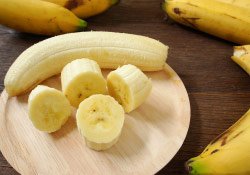
3. Bananas
Naturally sweet and soft, bananas are a great treat for dogs — especially when sliced and frozen. They’re high in potassium and fibre but also sugary, so feed sparingly.
Never feed the peel, as it’s tough to digest and can cause blockages.
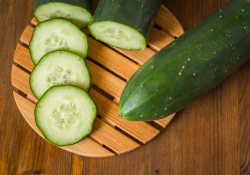
4. Cucumbers
Yes, it’s technically a fruit. (Thought it was a veg, didn’t you?) Cucumbers are light, crunchy, and full of water. They’re great for overweight dogs or warm weather, and some even say they help with doggy breath. Keep the skin on, slice thinly, and enjoy the crunch.

5. Mangoes
Juicy and rich in vitamin A, mango is safe for dogs once peeled and pitted. Cut into chunks and serve fresh. Avoid giving the skin or stone.
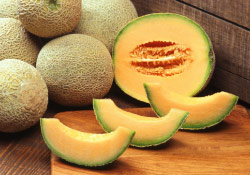
6. Melons (Cantaloupe and Honeydew)
Melons like cantaloupe and honeydew are naturally hydrating and full of fibre, potassium, and vitamins A and C. They’re also low in calories, making them great for warm weather treats — especially for dogs who need a little help staying cool. Always remove the rind and seeds, and serve in small amounts. Melons are naturally sweet and contain natural sugars, so they’re best avoided for dogs with diabetes or weight issues.

7. Oranges and Citrus Fruits
Dogs can eat oranges, mandarins, and clementines in small amounts — but many find the smell off-putting. If your dog enjoys citrus, peel and offer a segment or two. Remove all seeds and pith. Never feed lemons or limes — they’re far too acidic.
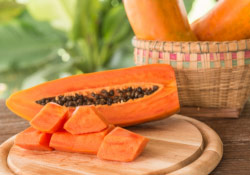
8. Papayas
Soft, easy to digest, and helpful for gut health. Peel and deseed before serving. A good option for dogs with sensitive tummies.

9. Peaches
Yes, dogs can have peaches — just not the pit. Slice off small amounts of flesh and skip anything tinned or syrupy. Fresh is best.
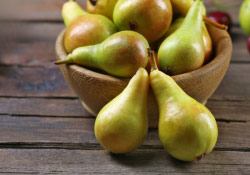
10. Pears
Gentle on tummies, slightly grainy in texture, and full of vitamins. As with apples, remove the seeds and core first. They’re a soft, easy-to-chew option for senior dogs too.
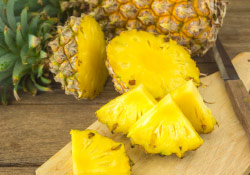
11. Pineapples
Pineapple is packed with natural enzymes that support digestion. Remove the spiky skin and hard core, and feed small pieces of the flesh as a treat.
Fun fact: Some people say pineapple can stop dogs from eating their own poo. The theory is that the enzyme bromelain makes the poo less appealing. There’s no solid evidence, but it’s a harmless trick to try. More importantly, pick up the poo straight away and keep your garden clean. If the habit continues, it’s worth checking in with your vet.

12. Plums
Similar to peaches, the flesh of a plum is fine in small amounts. Never give your dog the pit, as it can cause choking or digestive issues.

13. Tomatoes (Ripe Only)
Despite what you might’ve heard, ripe red tomatoes are safe for dogs in small amounts. They’re a source of potassium, vitamin C, and lycopene, a powerful antioxidant. Avoid stems, leaves, and green or unripe tomatoes — these can contain solanine and tomatine, which are harmful to dogs. Always serve ripe, red tomato flesh only, and skip sauces or anything seasoned.

14. Watermelons
Hydrating and refreshing — perfect for summer. Always remove the rind and seeds. Watermelon is mostly water, making it a safe, juicy snack when served cold.
A Note on Tinned Fruit
Tinned fruit might seem like a convenient option, but it usually contains added sugar, syrups, or preservatives that aren’t ideal for dogs. These extras can upset your dog’s stomach and add unnecessary calories.
If you do use tinned fruit, choose options with no added sugar or syrup, and rinse thoroughly before serving. Fresh or frozen fruit is always the healthier, safer choice.
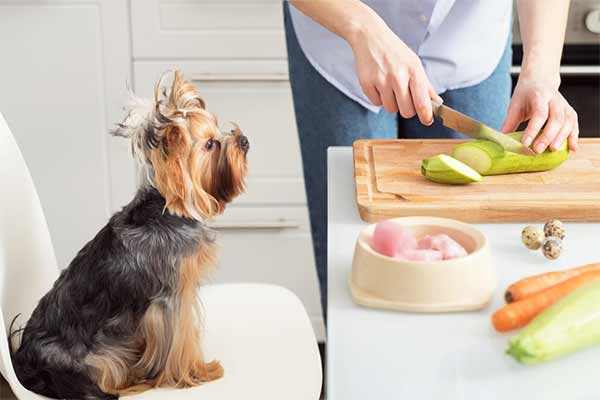
Vegetables Dogs Can Eat
Vegetables might not be the first thing that comes to mind when you think of dog food, but they’re surprisingly beneficial, and many dogs love them. Packed with fibre, vitamins, minerals, and plant compounds, vegetables can support digestion, help with weight control, and boost long-term health.
Most veg should be lightly cooked, steamed, or finely chopped to help your dog digest them more easily. Raw can be great too, depending on the vegetable and your dog’s individual tolerance. Always wash veg thoroughly and avoid seasoning or oil.
Just like fruit, vegetables should be served in moderation. Together, fruit and veg should make up no more than 10% of your dog’s daily diet.
Here’s a list of dog-safe vegetables that offer real health benefits when served properly.
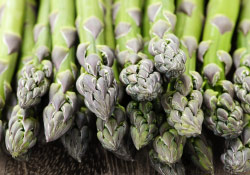
1. Asparagus
Asparagus is fibrous and full of prebiotics that feed good gut bacteria. It also contains vitamins A, C, E, and K.
Serve lightly cooked and chopped into bite-sized pieces. Raw asparagus is tough to digest and may cause gas or upset stomachs, so always steam first.
Dexter tip: After our cheeky spaniel once ate a cooked chicken bone off the street (thanks, takeaway litterbugs), our vet recommended steamed asparagus. Apparently, the fibres help wrap around small bone fragments and move them along. Not medical advice, of course, but it stuck with us — and we’re always happy to include a few spears when things get unpredictable.
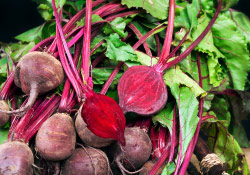
2. Beetroot
Beetroot is naturally sweet and earthy. It’s full of antioxidants, fibre, and folate, and it may help support digestion and skin health.
Only feed fresh, raw (washed thoroughly) or cooked beetroot — never pickled or tinned. Chop into small pieces and serve occasionally for a colourful nutrient boost.
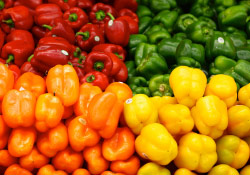
3. Bell Peppers
Red, yellow, orange, or green — bell peppers are all safe for dogs. They’re packed with vitamin A, vitamin C, B6, and beta-carotene, which support skin, coat, and eye health.
Red peppers contain the most nutrients. Remove seeds and white pith, and lightly steam or purée for better digestion.
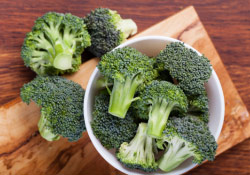
4. Broccoli
Broccoli is packed with nutrients and antioxidants that support detoxification and immune function. It’s especially rich in sulforaphane, a plant compound known for its anti-cancer properties.
Serve steamed or lightly cooked and chopped. A little goes a long way, as too much can cause gas or tummy upset. Avoid if your dog has thyroid issues, as cruciferous veg can interfere with thyroid function when overfed.
Don’t throw out the stalk! Once you peel off the tough outer layer, it makes a brilliant crunchy snack for your dog and helps reduce food waste.
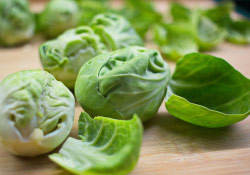
5. Brussels Sprouts
Brussels sprouts are full of fibre, antioxidants, and vitamins A, B, C, and K. They support gut health, immunity, and may help reduce inflammation.
Like other cruciferous veg, too many can cause gas or tummy upset, so start small. Serve steamed and finely chopped.

6. Cabbage
Cabbage is rich in antioxidants, fibre, and essential nutrients like folate, calcium, and vitamins A, B6, C, and K. It’s known to support digestion, skin health, and the immune system.
It can cause wind if overfed, so it’s best served steamed and in moderation.

7. Carrots
Crunchy, sweet, and full of fibre, carrots are a brilliant everyday veg for dogs. They’re naturally low in calories, rich in beta-carotene (which converts to vitamin A), and they support digestion, eye health, and the immune system. Serve them raw, steamed, grated, or puréed.
Puppy tip: Freeze raw carrot sticks for teething pups. They soothe sore gums, taste delicious, and double up as a safe, chewable distraction.

8. Cauliflower
Cauliflower is a low-calorie veg that’s full of fibre, vitamin C, and detox-supporting compounds like sulforaphane. It’s great for dogs needing to shed a little weight, and may help reduce inflammation.
Cooked is best — steaming or roasting brings out the flavour and makes it gentler on digestion. Like its cousin broccoli, too much can cause flatulence.

9. Celery
Crunchy and hydrating, celery is a good source of fibre, potassium, and vitamins. It’s also thought to help freshen dog breath naturally.
Serve raw in small sticks or finely chopped. It works well as a cooling summer snack or stuffed into enrichment toys.
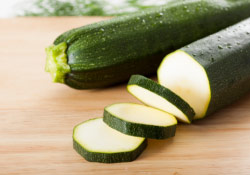
10. Courgette (Zucchini)
Light, hydrating, and easy on the digestive system, courgette is a great low-calorie treat. It contains antioxidants, potassium, and vitamin C.
Serve raw or steamed, cut into thin slices or diced. A great choice for dogs who enjoy crunch without the calories.
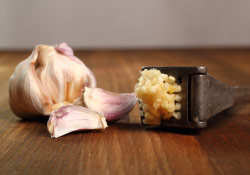
11. Garlic (Fresh Only, Prepared Correctly)
Garlic gets a bad reputation, but in tiny, properly prepared amounts, fresh garlic can actually benefit your dog’s health. It’s antibacterial, antiviral, antifungal, and supports the immune system.
Use only raw, organic garlic — chopped or crushed and left to sit for 10–15 minutes before feeding to activate allicin (the compound responsible for its benefits).
Feed the correct amount for your dog’s weight and never use garlic powder or pre-chopped jars.
We cover garlic in more depth in our Myth vs Fact section and Toxic Foods Guide.
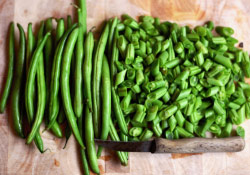
12. Green Beans
Low in calories and high in fibre, green beans are a great snack or food topper for dogs, especially those watching their weight. They’re also rich in vitamin K, vitamin C, and manganese.
Daisy tip: If your dog needs to slim down a little, try this trick. Reduce their regular food by 10% and replace that portion with chopped, steamed green beans. They’ll still feel full, but on fewer calories. It worked beautifully when Daisy had a couple of kilos to lose.
You can also serve green beans whole as a snack. Just snip off the stalk end before offering.
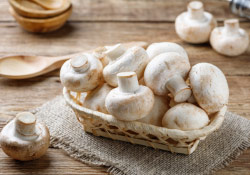
13. Mushrooms (Cooked, Safe Varieties Only)
Mushrooms can be fantastic — but only if they’re the right kind and properly prepared. Safe mushrooms like shiitake, reishi, lion’s mane, and maitake have been linked to immune and liver support, allergy relief, and even anti-cancer benefits.
Never feed wild mushrooms and never serve raw. Always cook store-bought edible mushrooms before offering them to your dog. Avoid anything tinned or packed in sauce.
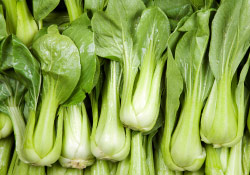
14. Pak Choi (Bok Choy)
Low in calories and rich in antioxidants, pak choi is a leafy green that supports immune health and digestion. The darker the leaves, the more nutrient-dense they are.
Wash thoroughly to remove dirt or pesticides, then chop finely and lightly steam or purée before serving. Think of it like cabbage — gentle but best in moderation.
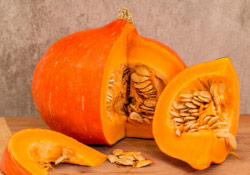
15. Pumpkin and Squash
Naturally sweet and rich in fibre, pumpkin and butternut squash are brilliant for digestive health. Both are packed with beta-carotene (a source of vitamin A), vitamin C, and antioxidants that support gut health, skin, and immune function.
Pumpkin is especially gentle on digestion — ideal for dogs with sensitive stomachs, diarrhoea, or constipation. Butternut squash, on the other hand, is slightly starchier but still a great source of fibre and vitamin C, and often appears in natural dog foods and treats.
Always serve cooked and plain. Avoid any tinned versions unless they’re 100% pure with no added sugar, salt, or spices.
Pumpkin seeds can also be fed occasionally in small amounts, but only shelled, plain, and ideally raw. They’re also thought to work as a natural dewormer — more on that later.
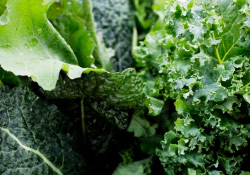
16. Spinach, Kale & Leafy Greens
Leafy greens are rich in iron, calcium, chlorophyll, and antioxidants. They support detoxification, digestion, skin and coat health, and immunity.
Feed in moderation, especially for dogs with kidney issues or thyroid problems, as they can be high in oxalates and goitrogens. Serve steamed, puréed, or finely chopped to aid digestion.
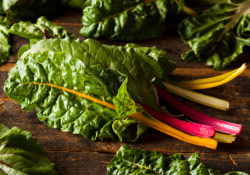
17. Swiss Chard
Swiss chard is rich in vitamins A, K, and C, along with fibre and antioxidants. It supports liver function, blood health, and immunity.
Feed in moderation, as too much can lead to gas or digestive issues. Serve steamed or finely chopped and mixed into meals.
A Note on Tinned Vegetables
While tinned vegetables might seem like a quick option, they often contain added salt or preservatives that aren’t ideal for dogs.
If you do use tinned veg, choose options labelled no added salt, and rinse them thoroughly before serving. Fresh, steamed, or lightly cooked veg will always be the better choice.
Health Benefits of Vegetables for Dogs
By now, you’ve seen which vegetables dogs can eat — but let’s talk about why they’re more than just crunchy toppings or colourful add-ons. Many of these dog-safe veg bring some serious functional benefits to the table (or the bowl), from gut health and detox to cancer prevention and immune support.
Here are just a few of the ways vegetables can support your dog’s long-term health.
Prebiotics for Gut Health
Veggies like asparagus, green beans, and leafy greens are packed with natural prebiotics — non-digestible fibres that feed the friendly bacteria in your dog’s gut. These bacteria play a big role in everything from digestion and immune function to mood and skin health.
Feeding your dog a variety of plant-based prebiotics can help maintain a diverse, thriving gut microbiome. A happy gut really does mean a happy dog.
What About Fermented Vegetables?
Fermented veg like sauerkraut, fermented carrot or beetroot, and raw unseasoned kimchi (minus garlic, onion, or chilli) can be a fantastic natural probiotic. These live cultures add beneficial bacteria to the gut, helping balance the microbiome, especially after antibiotics or during times of stress.
Feed tiny amounts to start — around half a teaspoon for small dogs or a teaspoon for larger dogs, mixed into meals. Make sure the product is raw, unpasteurised, and free from added salt, spices, or preservatives. If you’re into DIY, it’s easy to make your own in small batches too.
Fermented veg isn’t essential, but it’s one of those optional extras that can quietly work wonders for digestion, skin health, and even mood.
Detox Support & Liver Health
Leafy greens, beetroot, and cruciferous veg like broccoli are known for their detoxifying properties. They help support the liver’s natural function by aiding in the elimination of toxins from the body.
Dr Judy Morgan also highlights the role of vegetables in Traditional Chinese Veterinary Medicine (TCVM). According to TCM food energetics, certain vegetables — such as celery, asparagus, radish, and parsley — can help drain “damp” conditions, support the liver, and promote balanced energy in the body.
Cancer Prevention & Support
The anti-cancer potential of vegetables isn’t just folklore — it’s backed by science. A 2005 study by Purdue University found that Scottish Terriers who ate vegetables at least three times a week had a significantly reduced risk of developing transitional cell carcinoma (TCC), a type of bladder cancer. The strongest protective effect came from leafy greens and orange/yellow veg like pumpkin and carrots.
Cruciferous vegetables, mushrooms, and antioxidant-rich veg like beetroot and peppers are packed with protective compounds that support healthy cell function and may reduce inflammation linked to chronic disease.
Anti-Inflammatory Properties
Chronic inflammation is linked to everything from arthritis and skin allergies to more serious diseases like diabetes and cancer. Vegetables like broccoli, spinach, and bell peppers contain compounds that help calm inflammation and support tissue repair.
Even colour counts. The deeper and richer the colour, the more likely it is to contain anti-inflammatory flavonoids and carotenoids. Think green, red, orange, purple — variety really is key.
Immune-Boosting Compounds
Mushrooms deserve a spotlight here. Safe varieties like reishi, shiitake, turkey tail, and lion’s mane are packed with beta-glucans — compounds that modulate the immune system, making it smarter, not just stronger. These mushrooms have been studied for their potential in managing allergies, improving gut health, and supporting dogs going through cancer treatment.
Always cook mushrooms before feeding, and never forage wild. But when prepared correctly, they’re one of the most impressive plant-based ingredients in a dog’s wellness toolkit.
Toxic and Dangerous Fruits & Vegetables to Avoid for Dogs
- Grapes, raisins, sultanas, and currants – can cause kidney failure, even in very small amounts
- Onions, leeks, chives, and garlic powder – can damage red blood cells and lead to anaemia
- Avocado pits and skin – contain toxins and can cause choking or intestinal blockage
- Fruit seeds and stone fruit pits – many contain cyanide and pose a serious choking hazard
- Wild mushrooms – difficult to identify and potentially fatal if toxic
Myth vs Fact: What You’ve Heard vs What’s Actually True
There’s a lot of misinformation floating around when it comes to feeding your dog fresh food. Let’s clear a few things up, shall we?
- Myth: Dogs shouldn’t eat fruit — it’s too sugary
- Fact: Most fruits are totally safe when served in moderation, and many are packed with vitamins, fibre, and antioxidants. Berries in particular are low in sugar and high in anti-inflammatory benefits. Think of fruit as nature’s multivitamin, not a sugary snack. Just don’t overdo it.
- Myth: Garlic is toxic to dogs
- Fact: It’s all about quantity and preparation. While very large amounts or garlic powders can be harmful, fresh, raw, organic garlic in tiny, well-measured amounts may actually support your dog’s immune system, repel fleas and ticks, and act as a natural antibiotic.
- Myth: Wild berries are safe
- Fact: Absolutely not. Some wild berries look identical to their edible cousins but are toxic to dogs. Unless you're an expert forager, stick to shop-bought or homegrown only. When in doubt, leave it out.
- Myth: Mushrooms are poisonous to dogs
- Fact: Wild mushrooms can be fatal — yes. But safe, store-bought varieties like shiitake, reishi, lion’s mane and turkey tail are incredible when cooked. They support the immune system, gut health, and may even have anti-cancer properties. Always cook, never forage.
- Myth: Sweet potatoes are great for dogs
- Fact: They sound healthy, but they’re high in starch, which can feed yeast and harmful gut bacteria. Not toxic, but not especially beneficial — particularly for dogs with allergies, inflammation, or gut imbalances. There are better options.
- Myth: Coconut and coconut oil are superfoods for dogs
- Fact: Coconut products — especially coconut oil — were once hyped as miracle ingredients for everything from digestion to skin and coat health. But newer research tells a different story. Coconut is around 80% saturated fat and may actually contribute to inflammation, gut issues, and even leaky gut in some dogs. While it’s not toxic, it’s not the must-have it was once made out to be. There are better, more balanced fats to feed instead.
Further Reading: What Fruits and Vegetables Can Dogs Eat and What They Really Shouldn’t
We’re big believers in sharing our sources and giving credit where it’s due. If you’d like to explore the science behind some of the ingredients and ideas in this post, here are a few trusted articles we regularly refer to and recommend:
Berries for Dogs: Why Your Dog Needs More Polyphenols – Dogs Naturally Magazine
Polyphenols are natural compounds found in fruits, vegetables, herbs, and seeds. They act as powerful antioxidants, helping to reduce inflammation, protect cells from damage, and support gut and immune health. This is an excellent article on the role of polyphenols and why berries are so much more than just a sweet treat.
Berries for Dogs – DogCancer.com
A medically reviewed, in-depth look at how berries may support dogs with cancer through compounds like quercetin (a natural anti-inflammatory and allergy-fighting compound), ellagic acid (known for helping stop cancer cells from growing), and anthocyanins (powerful antioxidants that give berries their rich colour and protect against cell damage).
What Vegetables Can Dogs Eat? – Dogs Naturally Magazine
A helpful overview of dog-safe vegetables, including nutrient highlights and how to prepare them safely.
Mushrooms for Dogs – Dr Judy Morgan
Holistic insights into the power of medicinal mushrooms for immune support and beyond.
Benefits of Vegetables – Dr Judy Morgan
A Traditional Chinese Medicine perspective on how veg can be used to balance energy, support specific organs, and promote healing.
Disclaimer: This post is not sponsored or affiliated with any of the experts, articles, or publications we’ve mentioned. We reference their work because we trust it, learn from it, and believe in sharing valuable information with fellow dog parents.
At The Luna Collection, we believe in a natural, holistic, and joyful approach to raising our dogs. That includes fresh food, real ingredients, thoughtful choices, and the freedom to learn together.
We hope this guide helps you feel more confident in feeding the dogs you love.
Frequently Asked Questions
We’ve covered a lot in this guide, but here are some of the most common questions we hear from fellow dog parents when it comes to feeding fruit and veg.
What fruit or vegetables can dogs eat?
Dogs can safely enjoy a wide range of fruits and vegetables, including carrots, apples, blueberries, pumpkin, green beans, courgette, and spinach. We’ve listed all the best options — along with how to serve them — in our full Fruits Dogs Can Eat and Vegetables Dogs Can Eat sections above.
Just remember, fruit and veg combined should make up no more than 10% of your dog’s daily diet
What fruits and vegetables can’t dogs eat?
We’ve summarised the top ones in our Toxic and Dangerous Fruits & Vegetables to Avoid for Dogs section, and you can find the full breakdown in our separate toxic foods guide.
What fruits and vegetables can I give my dog for treats?
Some of the best natural treats include:
- Carrot sticks (raw or frozen)
- Apple slices (no seeds)
- Blueberries, raspberries, and blackberries
- Green beans (raw or lightly steamed)
- Cucumber slices
These are all easy to prep, naturally low in calories, and far better than most shop-bought dog treats. Perfect for training or enrichment toys.
What vegetables can dogs eat every day?
Some vegetables are safe and beneficial to feed daily, especially in small amounts as part of a balanced bowl. These include:
- Carrots
- Courgette
- Pumpkin
- Green beans
- Cucumber
- Celery
- Spinach and other leafy greens (in moderation)
- Broccoli (just a little)
Rotate them to give your dog a variety of nutrients, and always chop, steam, or purée where needed for easier digestion.
Share This Post



